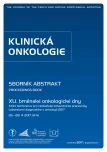Ascites May Provide Useful Information for Diagnosis of Ovarian Cancer
Authors:
E. Stuchlíková 1; M. Zahradníková 1; R. Nenutil 1,2; D. Valík 1,3; B. Vojtěšek 1; M. Novotný 1; L. Hernychová 1
Authors‘ workplace:
RECAMO, Masarykův onkologický ústav, Brno
1; Oddělení onkologické patologie, Masarykův onkologický ústav, Brno
2; Oddělení laboratorní medicíny, Masarykův onkologický ústav, Brno
3
Published in:
Klin Onkol 2017; 30(Supplementum1): 187-190
Category:
Article
Overview
Background:
Ovarian cancer is the most lethal gynecological cancer, almost 80% of all patients succumb the disease within 5 years of diagnosis. High mortality is caused especially by nonspecific symptoms, diagnosis in late stages and the absence of a specific biomarker. Currently, the most common diagnostic biomarkers are the membrane glycoprotein Cancer Antigen 125 (CA 125), the Human Epididymal Protein 4 (HE4) and the Carcinoembryonic Antigen (CAE). None of these biomarkers is specific only for ovarian cancer and increased levels may be caused by other diseases. Therefore, current research is focused on finding new biomarkers for diagnosis and prognosis of ovarian cancer. Interesting clinical material is ascites, the fluid accumulated in abdominal cavity, which is typical for ovarian cancer and it is present in almost 90% of all cases of stage III and IV.
Material and Methods:
For this study, samples of ascites from patients with benign and malignant ovarian tumors were used. For full glycomic and proteomic analysis, only 5 µL of ascites were used. Glycans were released from proteins by the enzyme PNGase F and proteins were digested to peptides by trypsin. Samples were purified and measured using a mass spectrometer.
Results:
Glycan and protein profiles of patients with benign and malignant ovarian cancer were compared. In patient with a benign tumor, more simple glycans with low m/z were increased while in the patient with a malignant tumor, higher, more complex glycans were increased. In the malignat tumor in comparison to benign tumor, 127 unique proteins were identified, especially proteins of the annexin, mucin and peroxiredoxin families.
Conclusion:
This investigation is a pilot study focused on comparison of protein and glycan composition of ascites in patients with benign and malignant ovarian cancer. Significant differences were found on both glycan and protein levels. Results will be verified on a larger set of patients and compared with a set of control samples.
Key words:
glycomics – proteomics – ascitic fluid – ovarian cancer
This study was supported by projects of the Ministry of Education Youth and Sports – National Sustainability Program I – LO1413; Ministry of Health, Czech Republic – conceptual development of research organization (MMCI, 00209805); Czech Science Foundation 16-04496S.
The authors declare they have no potential conflicts of interest concerning drugs, products, or services used in the study.
The Editorial Board declares that the manuscript met the ICMJE recommendation for biomedical papers.
Submitted:
13. 3. 2017
Accepted:
26. 3. 2017
Sources
1. Smolle E, Taucher V, Haybaeck J. Malignant ascites in ovarian cancer and the role of targeted therapeutics. Anticancer Res 2014; 34 (4): 1553–1561.
2. Biskup K, Braicu EI, Sehouli J et al. The serum glycome to discriminate between early-stage epithelial ovarian cancer and benign ovarian diseases. Dis Markers 2014; 2014: 238197. doi: 10.1155/2014/238197.
3. Bast RC Jr, Hennessy B, Mills GB. The biology of ovarian cancer: new opportunities for translation. Nat Rev Cancer 2009; 9 (6): 415–428. doi: 10.1038/nrc2644.
4. Ahmed N, Stenvers KL. Getting to know ovarian cancer ascites: opportunities for targeted therapy-based translational research. Front Oncol 2013; 3: 256. doi: 10.3389/fonc.2013.00256.
5. Kim A, Enomoto T, Serada S et al. Enhanced expression of Annexin A4 in clear cell carcinoma of the ovary and its association with chemoresistance to carboplatin. Int J Cancer 2009; 125 (10): 2316–2322. doi: 10.1002/ijc.24587.
6. Yan X, Yin J, Yao H et al. Increased expression of annexin A3 is a mechanism of platinum resistance in ovarian cancer. Cancer Res 2010; 70 (4): 1616–1624. doi: 10.1158/0008-5472.CAN-09-3215.
7. Kalinina EV, Berezov TT, Shtil’ AA et al. Expression of peroxiredoxin 1, 2, 3, and 6 genes in cancer cells during drug resistance formation. Bull Exp Biol Med 2012; 153 (6): 878–881.
8. Alley WR, Vasseur JA, Goetz JA et al. N-linked glycan structures and their expressions change in the blood sera of ovarian cancer patients. J Proteome Res 2012; 11 (4): 2282–2300. doi: 10.1021/pr201070k.
9. Saldova R, Royle L, Radcliffe CM et al. Ovarian cancer is associated with changes in glycosylation in both acute-phase proteins and IgG. Glycobiology 2007; 17 (12): 1344–1356.
Labels
Paediatric clinical oncology Surgery Clinical oncologyArticle was published in
Clinical Oncology

2017 Issue Supplementum1
Most read in this issue
- Ascites May Provide Useful Information for Diagnosis of Ovarian Cancer
- Lactate Dehydrogenase – Old Tumour Marker in the Light of Current Knowledge and Preanalytic Conditions
- Molecular Pathology of Colorectal Cancer, Microsatellite Instability – the Detection, the Relationship to the Pathophysiology and Prognosis
- Circulating Myeloid Suppressor Cells and Their Role in Tumour Immunology
